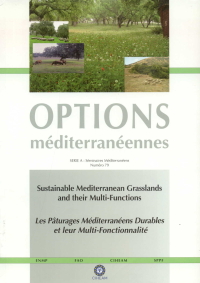| Article précédent | p. 293-297 | Article suivant |
The effect of salinity and high temperature on biomass production of some alfalfa landraces
In Morocco, local populations of alfalfa (Medicago sativa L.) are being used in the traditional farming systems, which mainly consist of mountains and pre-saharian oasis. Although, these materials are adapted to biotic and abiotic stresses (salinity, high temperature and drought), the detailed agronomic and physiological characterization of those lines has to be carried out. Therefore, the present study aimed to know the effect of the abiotic stresses (salinity and high temperature) on some agronomic and physiological characteristics of four alfalfa landraces, namely Demnate, Dades, Rich and Gabes. The study revealed that high temperature, salinity and their combined effect significantly reduced shoot and root growth compared to control treatments. Under the combined effect of these stresses, plant height, internode number and distance were higher in Demnate and Rich landraces, compared to the control population (Gabes). The landrace Dades was sensitive to all the three stress treatments. The physiological studies showed that the combined effect of salinity and high temperature decreased Na+ and Cl- penetration, increased Mg2+ absorption and maintained adequate levels of chlorophyll a and b in the cells, thus indicating a normal process of photosynthesis in all the 4 landraces in response to stress. Relative water content (RWC) in the leaf was decreased in all the landraces as a result of the combined effect the two stresses. However, the decrease was very small in the case of Demnate. Our study showed that, in general, salt tolerance in alfalfa seems to be quiet linked to heat tolerance, suggesting that selection against one stress (high temperature or salinity) could lead to tolerance to the other stress.
Au Maroc, les populations locales de luzerne (Medicago sativa L.) des montagnes et des oasis présahariennes sont utilisées dans les systèmes agricoles traditionnels. Bien que ces populations soient adaptées aux stress biotiques et abiotiques (salinité, température élevée et sécheresse), leur caractérisation agronomique et physiologique nécessite une étude approfondie. Par conséquent, la présente étude vise à connaître les effets des stress abiotiques (salinité et température élevée) sur certaines caractéristiques physiologiques et agronomiques de quatre cultivars de luzerne, à savoir Demnate, Dadès, Rich et Gabès. L'étude a révélé que la température élevée, la salinité et leur effet combiné ont significativement réduit la croissance du système racinaire et de la partie aérienne par rapport au témoin. Sous l'effet combiné (salinité et température élevée), la hauteur de la plante, et la distance entre les entre-nœuds étaient plus élevées chez les populations Demnate et Rich en les comparant à la population témoin Gabès. La population Dadès était la plus sensible aux trois traitements étudiés. Les études physiologiques ont montré que l'effet combiné de la température élevée et de la salinité a diminué la pénétration excessive des ions Na+ et Cl-, en augmentant l'absorption de Mg2 + et en maintenant une teneur en chlorophylle a et b assez adéquate pour le déroulement du processus photosynthétique. L'effet du stress combiné température-salinité sur la teneur relative en eau, s'est traduit par une perte d'eau au niveau des feuilles de toutes les populations étudiées. Toutefois, la population Demnate se distingue des autres populations par une meilleure teneur. Notre étude a montré que, en général, la tolérance de la luzerne au sel semble être liée à la tolérance à la température élevée, ce qui suggère que la sélection contre l'un des deux stress (température élevée ou salinité) pourrait conduire à la tolérance aux autres stress.
- [ Afficher ]
- [ Télécharger ]
- [ Exporter la citation ]
Vous pouvez télécharger la citation au format :
- [ Imprimer ]
-
Mots-clés
CARACTERE AGRONOMIQUE, LUZERNE, MEDICAGO SATIVA, STRESS, STRESS THERMIQUE, TOLERANCE AU SEL, VARIETE INDIGENECiter cet article
Elboutahiri N., Thami Alami I., Ibriz M., Alfaiz C. The effect of salinity and high temperature on biomass production of some alfalfa landraces. In : Porqueddu C. (ed.), Tavares de Sousa M.M. (ed.). Sustainable Mediterranean grasslands and their multi-functions . Zaragoza : CIHEAM / FAO / ENMP / SPPF, 2008. p. 293-297. (Options Méditerranéennes : Série A. Séminaires Méditerranéens; n. 79). 12. Meeting of the Sub-Network on Mediterranean Forage Resources of the FAO-CIHEAM Inter-regional Cooperative Research and Development Network on Pastures and Fodder Crop, 2008/04/09-12, Elvas (Portugal). http://om.ciheam.org/om/pdf/a79/00800664.pdf



